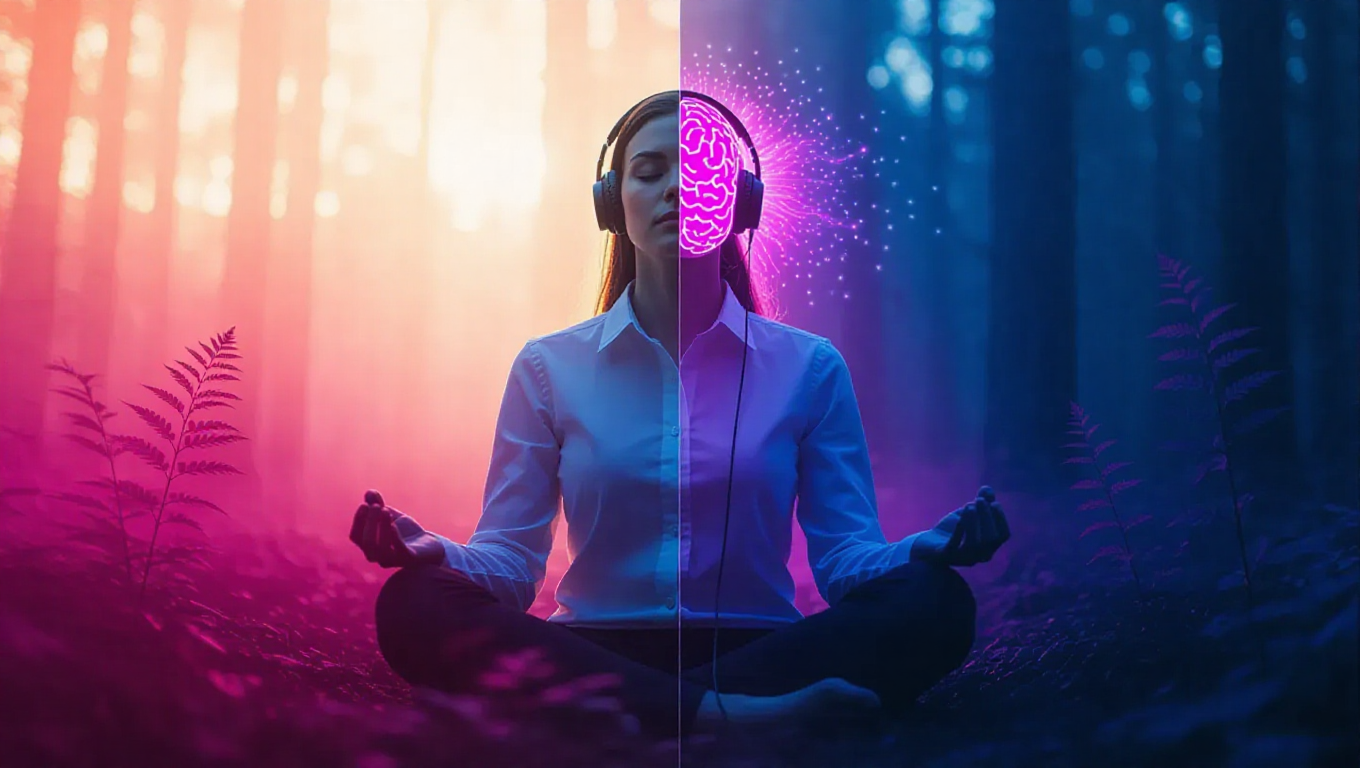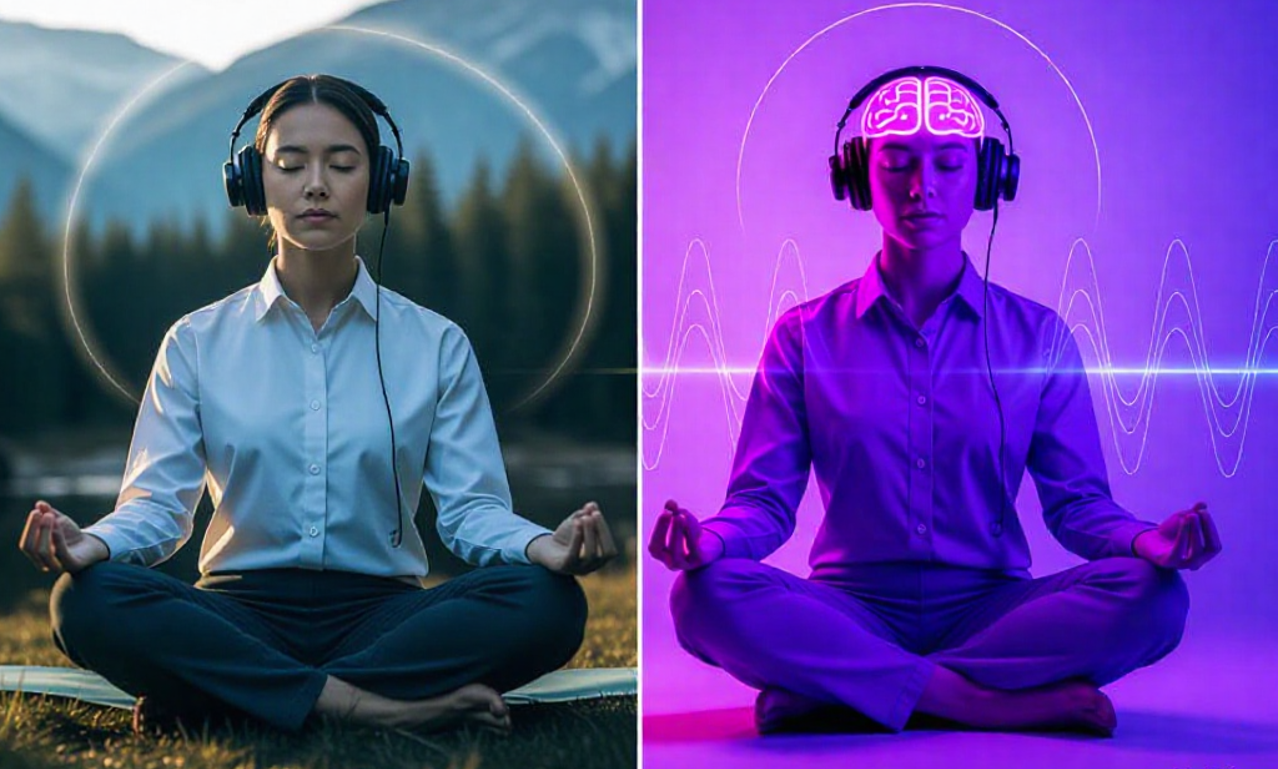Beyond Meditation: Can Binaural Beats Combat Workplace Stress? A Scientific Look
The modern professional landscape is demanding, characterized by constant connectivity, high expectations, and relentless pressure to perform. While ambition drives progress, it often comes at a significant cost: escalating levels of workplace stress and, increasingly, burnout. Recognizing this challenge, forward-thinking organizations are prioritizing Corporate Wellness, Wellbeing, and Mental Wellness initiatives more than ever before. The search is on for effective, accessible tools that can help employees navigate these pressures and maintain their mental equilibrium. Traditional Meditation practices have long been recognized for their potential benefits, offering a path to inner calm through focused attention and awareness. However, a newer contender has emerged in the wellness space, sparking curiosity and debate: Binaural Beats. These auditory illusions, generated through headphones, are purported to influence brain activity and promote relaxation or focus. But can this relatively passive approach truly compare to the established practice of meditation, especially in the context of managing professional stress and preventing burnout? This article delves into the scientific literature to compare these two distinct approaches, examining the evidence behind their effectiveness and exploring whether binaural beats might offer a viable alternative or complement to meditation for today's busy professionals.
The Modern Professional's Burden: Understanding Stress and Burnout
Before exploring potential solutions, it is crucial to understand the nature of the challenges many professionals face. Workplace stress is not merely feeling busy; it is a physical and emotional response that occurs when job requirements do not match the capabilities, resources, or needs of the worker. It can manifest as anxiety, irritability, difficulty concentrating, and physical symptoms like headaches or fatigue. When this stress becomes chronic and unmanaged, it can escalate into burnout. Burnout is a more severe state characterized by three key dimensions: overwhelming exhaustion (feeling physically and emotionally drained), cynicism and detachment from one's job (a loss of engagement and enthusiasm), and a sense of ineffectiveness and lack of accomplishment (feeling incompetent and unproductive). The impact extends far beyond the individual, affecting personal relationships, overall health, and contributing to decreased productivity, increased absenteeism, and higher turnover rates within organizations. This highlights the urgent need for effective, evidence-supported strategies that promote mental wellness and build resilience against the pressures of the modern workplace.
Meditation: The Established Practice for Inner Calm
Meditation is a practice with ancient roots, but its application in modern wellness, particularly for stress management, is backed by a growing body of scientific research. At its core, meditation involves training attention and awareness to achieve a mentally clear and emotionally calm state. While there are many forms, techniques relevant to stress reduction often emphasize either focused attention (concentrating on a single point, like the breath or a sound) or open monitoring (observing thoughts, feelings, and sensations without judgment), commonly known as mindfulness. Unlike relaxation techniques that simply aim to reduce tension, meditation aims to cultivate a deeper understanding of the mind and develop skills to manage thoughts and emotions more effectively. It is an active mental training process.
The scientific community has extensively studied meditation's effects. A significant systematic review and meta-analysis published in JAMA Internal Medicine (Goyal et al., 2014) examined 47 randomized clinical trials involving over 3500 participants. This rigorous analysis found moderate evidence that mindfulness meditation programs improved anxiety, depression, and pain after about 8 weeks of practice, with some benefits persisting for 3-6 months. However, the evidence for improving stress/distress specifically, or mental health-related quality of life, was considered low. Importantly, the review found no evidence that meditation programs were more effective than other established active treatments like medication, exercise, or other behavioral therapies. This suggests meditation is a valuable tool, but perhaps one among several effective options, rather than a universally superior solution.
Engaging in meditation requires commitment. It is a skill that develops with consistent practice over time. While simple guided meditations can offer immediate, temporary relief, reaping the more profound, lasting benefits typically involves regular sessions, active participation, and often, guidance from experienced instructors or structured programs. It is not a passive fix but an investment in mental training and self-awareness.
Binaural Beats: Auditory Illusions for Brainwave Entrainment?
Distinct from the active mental training of meditation, binaural beats represent a more passive approach rooted in auditory perception. The phenomenon itself is fascinating: when you listen through headphones to two slightly different sound frequencies, one in each ear (e.g., 440 Hz in the left, 450 Hz in the right), your brain perceives a third, rhythmic pulse – a "beat" – at the difference between those two frequencies (in this example, 10 Hz). This perceived beat isn't actually present in the sound waves; it's an auditory illusion created within the brain.
The core theory behind the therapeutic use of binaural beats is called "brainwave entrainment" or "frequency following response." The idea is that exposing the brain to this rhythmic beat can encourage brainwaves – the electrical activity patterns associated with different mental states – to synchronize with the beat's frequency. For instance, listening to a binaural beat in the alpha range (8-13 Hz) is hypothesized to promote alpha brainwave activity, which is typically associated with relaxed wakefulness. Similarly, theta range beats (4-7 Hz) might encourage theta activity, often linked to deep relaxation, meditation, and certain stages of sleep. Proponents suggest that by guiding brainwaves towards desired states, binaural beats could potentially reduce anxiety, improve focus, or facilitate relaxation.
However, when we turn to the scientific evidence, the picture becomes less clear. A systematic review published in Psychological Research (García-Argibay et al., 2023) specifically investigated whether binaural beat stimulation reliably affects brain oscillatory activity (brainwaves). After analyzing 14 relevant studies, the researchers found mixed results. Only five studies reported findings consistent with the brainwave entrainment hypothesis, while eight studies found no significant effects, and one reported mixed outcomes. The review concluded that due to significant differences in methodologies across studies (like the frequencies used, duration of listening, and measurement techniques), the question of whether binaural beats consistently entrain brainwaves remains open. The underlying mechanism, while intriguing, is not yet robustly confirmed by consistent scientific evidence.
What about the effects on psychological outcomes like stress, anxiety, or cognitive function? Research here is also varied. Some individual studies and smaller reviews suggest potential benefits, particularly for short-term anxiety reduction. However, the overall body of evidence is generally considered less extensive and of more variable quality compared to the research on meditation. Many studies suffer from methodological limitations, small sample sizes, or lack of adequate control groups, making it difficult to draw firm conclusions about effectiveness beyond potential placebo effects. While some users report positive experiences, the scientific backing for binaural beats as a reliable tool for managing stress, enhancing cognition, or replacing meditation is currently less established.
Despite the inconclusive scientific consensus on the mechanism and consistent effects, the appeal of binaural beats for some individuals is understandable. The primary draw is often its passive nature. Unlike meditation, which requires active mental effort and practice, using binaural beats simply involves putting on headphones and listening, making it seem like an easier entry point for those seeking relaxation or stress relief without dedicated training.
Comparing Approaches: Meditation vs. Binaural Beats
Having examined both meditation and binaural beats individually, how do they stack up against each other as tools for managing stress and promoting mental wellness in a professional context? Several key differences emerge when comparing their evidence base, proposed mechanisms, and user experience.
Firstly, the evidence base differs significantly. Meditation, particularly mindfulness-based approaches, boasts a much larger and more established body of scientific research, including numerous high-quality randomized controlled trials and systematic reviews like the one by Goyal et al. (2014). While not a panacea, this research provides moderate confidence in its ability to reduce symptoms of anxiety, depression, and pain. In contrast, the research on binaural beats is considerably newer, more limited, and often of lower methodological quality. As highlighted by the García-Argibay et al. (2023) review, even the fundamental mechanism of brainwave entrainment lacks consistent support. While some studies suggest potential benefits for anxiety or cognition, the overall evidence is less robust and conclusive.
Secondly, their proposed mechanisms of action are fundamentally different. Meditation is an active form of mental training. It involves consciously directing attention, developing awareness, and learning to relate differently to one's thoughts and feelings. It is about building internal skills. Binaural beats, conversely, rely on a passive auditory stimulation model. The proposed benefit hinges on the brain automatically responding to the perceived beat, potentially shifting brainwave activity without conscious effort from the listener – a mechanism still under scientific debate.
This leads to a difference in user experience and required effort. Meditation requires active engagement, discipline, and consistent practice to develop proficiency and achieve lasting benefits. It is a skill to be cultivated. Binaural beats offer a passive experience; the user simply needs to listen. This lower barrier to entry might make binaural beats appealing to individuals seeking immediate relaxation or those hesitant to commit to the active practice required by meditation. However, the long-term skill-building aspect inherent in meditation may offer more profound and sustainable changes in stress management capabilities.
Finally, regarding accessibility, both are relatively accessible. Meditation can be practiced anywhere with minimal equipment, and numerous apps and online resources offer guidance. Binaural beats require headphones and a device to play the audio tracks, which are also widely available. The primary difference lies less in physical accessibility and more in the type of engagement required.
The Personalization Factor: Why One Size Rarely Fits All
While comparing the general evidence for meditation and binaural beats is informative, it is crucial to acknowledge a fundamental truth in wellness: personalization matters. Individual responses to any intervention, whether it is a meditation technique, an auditory stimulation like binaural beats, exercise, or even medication, can vary significantly. What works wonders for one person might have little effect on another.
Several factors contribute to this variability. Baseline stress levels, personality traits, specific goals (e.g., reducing anxiety vs. improving focus), the environment in which the technique is practiced, and, critically, the consistency and duration of use all play a role. Furthermore, much of the existing research, for both meditation and binaural beats, tends to use standardized, one-size-fits-all protocols to ensure experimental control. This necessary scientific approach often doesn't reflect how these tools might be best utilized in real-world scenarios, where tailoring the approach to the individual could yield better results.
This highlights a gap between standardized research findings and optimal practical application. Recognizing that individual brain activity and stress responses differ, the future of effective stress management and mental wellness likely lies in more personalized approaches. Fields like Neurofeedback and Biofeedback, for instance, focus specifically on providing real-time feedback about physiological signals (like brainwaves or heart rate variability), allowing individuals to learn how to consciously regulate their own internal states. This principle of personalized training, based on individual biological data, offers a promising direction for developing more targeted and effective strategies for combating stress and burnout.
Conclusion: Finding Your Path to Mental Wellness
In the quest for effective stress management and burnout prevention strategies, both meditation and binaural beats present intriguing possibilities. The scientific evidence suggests that meditation, particularly mindfulness-based practices, stands as a well-validated tool with moderate support for reducing anxiety, depression, and pain, although it requires active practice and commitment. Binaural beats offer a more passive approach that appeals to some, and while preliminary research hints at potential benefits like short-term anxiety reduction, the underlying mechanism of brainwave entrainment remains scientifically debated, and the overall evidence for its effectiveness is less consistent and robust compared to meditation. Ultimately, the most effective approach is often personal. Understanding the science is the first step, but exploring what resonates with your individual needs and preferences is key.
Ready to explore personalized strategies for managing stress and boosting mental wellness? Subscribe to the MelodiaSync.com mailing list for the latest insights and updates on evidence-based approaches.


